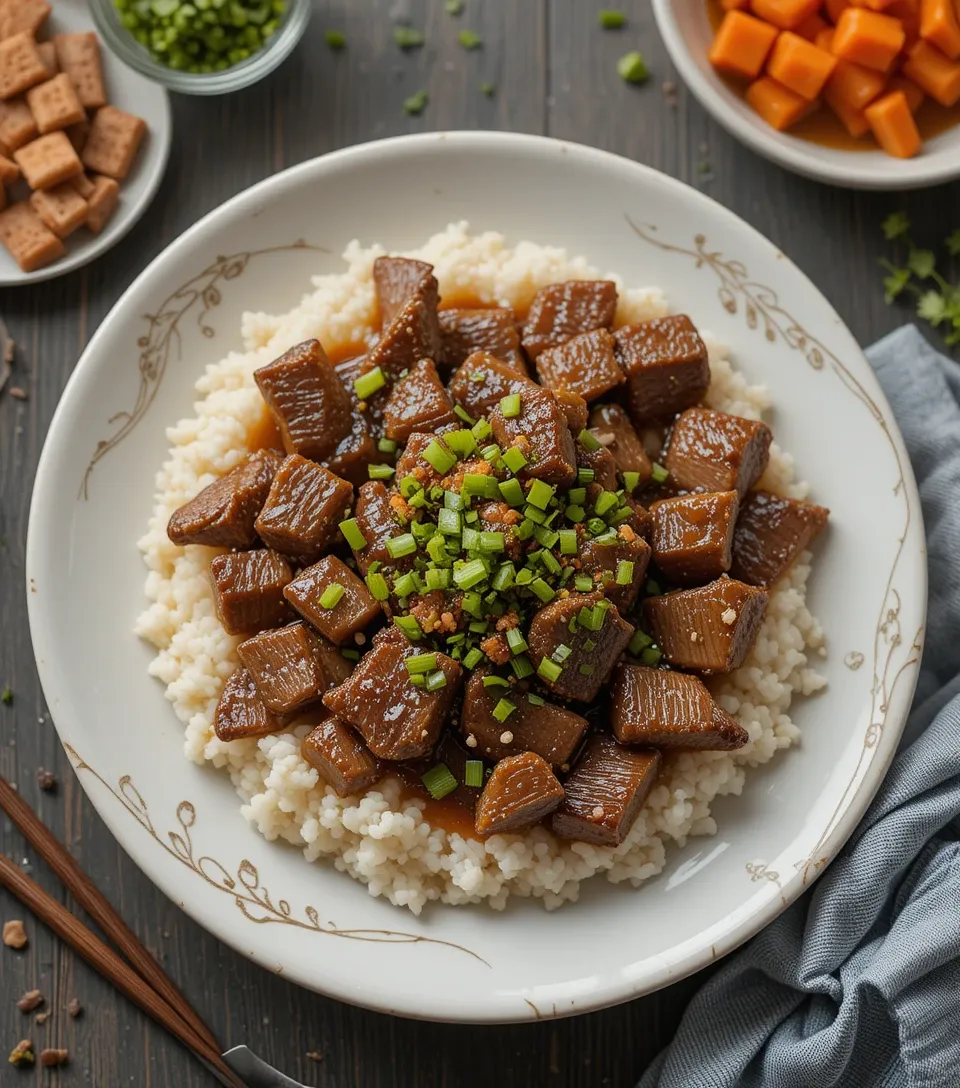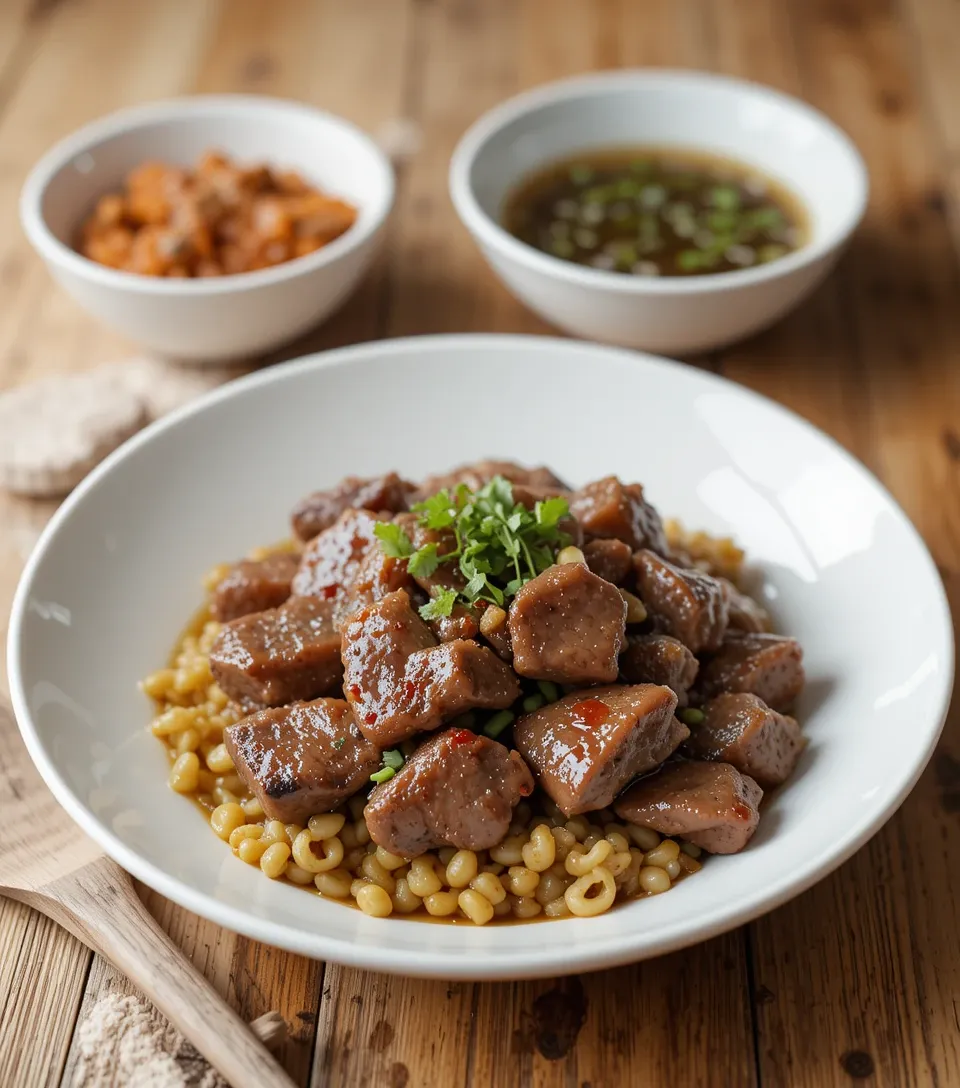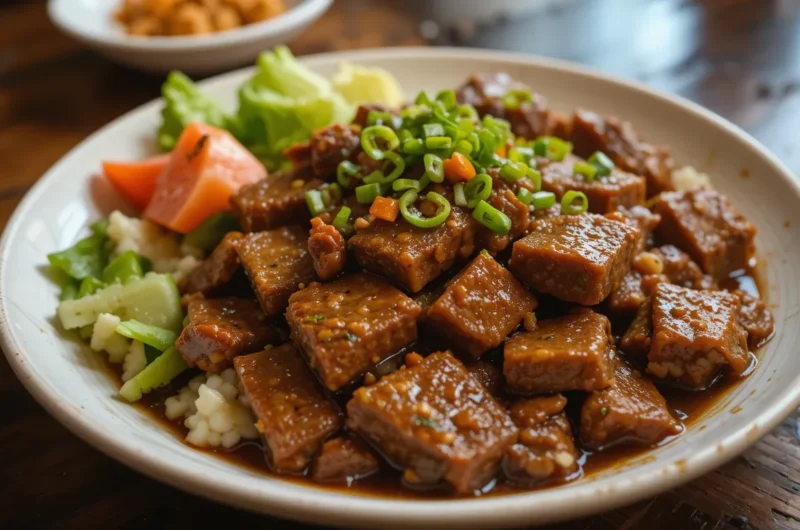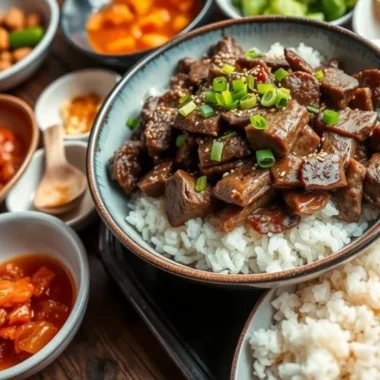As I explore Korean cuisine, the smell of beef bulgogi takes me back to Seoul’s busy streets. This dish, with its perfect mix of flavors and tender beef, is a favorite at home. It reminds me of the rich food traditions passed down through generations.
Whether you’re a seasoned cook or just starting out, making beef bulgogi is a rewarding journey. It’s a Korean BBQ classic that promises a great experience.
Table of Contents
Understanding Korean Bulgogi: Origins and Tradition
Korean barbecue, or “Korean barbecue,” has been loved for centuries. At its core is bulgogi, a tasty and soft beef dish. It has won the hearts of food lovers everywhere.
The History Behind “Fire Meat”
The story of bulgogi starts in the Goguryeo era (37 BC–668 AD). It was called “maekjeok” back then, meat grilled on a skewer. Later, it changed to grilling on a grate, known as “neobiani” in the Joseon Dynasty (1392–1897). Now, it’s called “bulgogi,” or “fire meat,” because it’s grilled over an open flame.
Cultural Significance in Korean Cuisine
Bulgogi is very important in Korean food culture. It’s often served at big events and gatherings. It shows the joy and celebration of Korea, and its deep traditions.
Evolution of Cooking Methods
The way bulgogi is made has changed a lot over time. It started with skewers, then moved to pan-frying and grilling. Despite these changes, it still keeps its core flavors and essence. This makes bulgogi a favorite in Korea and around the world.
“Bulgogi is more than just a dish – it’s a cultural icon that embodies the essence of Korean cuisine and the country’s rich culinary traditions.”
Essential Ingredients for Authentic Beef Bulgogi Recipe
Making the perfect beef bulgogi needs careful picking of key ingredients. These ingredients give the dish its unique sweet and savory taste. At the core is thinly sliced beef, often from the ribeye or sirloin.
The must-haves for authentic beef bulgogi are:
- Soy sauce: It adds a savory base and umami depth
- Brown sugar: It brings a subtle sweetness to balance the flavors
- Mirin (rice wine): It enhances the flavor and tenderizes the beef
- Sesame oil: It adds a nutty aroma and richness
- Black pepper: It adds a touch of warmth and spice
- Asian pear or apple: It acts as a natural tenderizer and sweetness enhancer
- Onion, garlic, and ginger: They add aromatic complexity to the marinade
Adding green onions, carrots, and Korean red pepper flakes (gochugaru) can also enhance the flavor. These ingredients together create the unique taste and texture of beef bulgogi. It’s why this dish is so loved in Korean cuisine.
Learning to make beef bulgogi begins with knowing the essential ingredients. By choosing and balancing these key components, you can bring out the true essence of this Korean classic.
Selecting and Preparing the Perfect Cut of Beef
Choosing the right meat is key to making great Korean beef bulgogi. Look for cuts like rib eye, tenderloin, sirloin, or striploin. These are tender, well-marbled, and offer amazing flavor and texture.
Best Beef Cuts for Bulgogi
- Rib eye (scotch fillet): Known for its juicy taste and tender feel.
- Beef tenderloin: Very tender and lean, making it a luxury choice.
- Top sirloin: A great cut that’s flavorful and affordable.
- Strip loin (NY strip): A mix of tenderness and beefy taste.
Proper Slicing Techniques
For the best bulgogi, slice the beef thinly against the grain. This makes it tender and easy to chew. To slice easily, freeze the beef for 2-2.5 hours. Then, cut it into 2-3mm (1/8 inch) strips.
Meat Tenderizing Methods
Using the right cut is important, but tenderizing can make it even better. Try using Asian pear enzymes to soften the meat. Blend 25% of the marinade with pear puree and marinate for at least 1 hour. You can also use pineapple, kiwi, or peach for similar results.
The Secret to Perfect Bulgogi Marinade
Making a great beef marinade is key to enjoying Korean barbecue like bulgogi. This marinade has the right mix of soy sauce, brown sugar, and rice wine. It also includes Asian pear or apple, onion, garlic, ginger, and black pepper.
To make the perfect bulgogi sauce, just blend these ingredients until they’re smooth. Adding a bit of sesame oil to the meat before marinating is a good idea. It seasons the beef and makes it tender, giving it that special texture.
Marinating the meat for 4 hours to overnight is important. The longer it marinates, the stronger the flavors will be. Before you add the marinade to your beef, taste it and adjust the seasoning to your liking.
Learning how to make a great beef marinade is the first step to a real Korean barbecue at home. With the right ingredients and marinating time, you’ll get that delicious, caramelized outside and tender inside of bulgogi.
Mastering the Korean BBQ Cooking Technique
Preparing the perfect Korean barbecue requires the right cooking technique. Beef bulgogi, a savory grilled beef dish, can be cooked two ways: grilling or pan-frying. Each method brings its own flavors, letting you choose what you like best.
Grilling vs. Pan-Frying Methods
Grilling bulgogi over high heat gives it a smoky char and caramelized edges. This method adds a bold, delicious flavor to Korean barbecue. On the other hand, pan-frying in a seasoned cast-iron skillet makes the meat tender and juicy. It also helps the marinade flavor blend well with the beef.
Temperature Control Tips
Temperature control is crucial for perfect Korean barbecue at home. For grilling, preheat your grill to high heat before adding the beef. Cook for 3-5 minutes per side to keep it juicy inside and charred outside. When pan-frying, use medium-high heat and cook in batches to prevent steaming and ensure even browning.
Achieving the Perfect Char
The charred crust is key to Korean barbecue‘s full flavor. To get this, keep the heat high and don’t overcrowd the grill or skillet. Cook quickly to caramelize the marinade’s sugars and create a tasty crust without drying out the meat. By mastering grilling or pan-frying, you can enjoy Korean barbecue in your own kitchen.
Traditional Serving Suggestions and Accompaniments

Serving Korean barbecue dish, beef bulgogi, can be done in many ways. It’s often paired with Korean side dishes, called banchan. These dishes enhance the savory and sweet flavors of the beef.
Wrapping bulgogi in lettuce leaves with ssamjang is a classic method. This mix of juicy beef, crunchy lettuce, and bold sauce makes for a tasty easy dinner.
- Kimchi, the iconic fermented cabbage, adds a tangy and spicy kick to the bulgogi.
- Perilla leaves offer a nutty flavor and are great for wrapping bulgogi.
- Steamed rice is essential, acting as a base to absorb the bulgogi’s juices.
- Japchae, a Korean noodle dish, adds a delightful texture.
- Pickled radish and radish chips bring a refreshing crunch and cleanse the palate.
For a modern twist, bulgogi can be used in fusion dishes like tacos or burritos. Its versatility makes it a great ingredient for many dishes.
“The true beauty of bulgogi lies in its ability to seamlessly blend tradition and innovation, making it a culinary delight that transcends cultural boundaries.”
Storage and Make-Ahead Tips
Beef bulgogi’s delicious flavors can last beyond the first meal. With a few simple tips, you can make this quick meat recipe a staple in your meals. Let’s see how to keep your beef bulgogi fresh and tasty for later.
Proper Storage Methods
Cooked beef bulgogi can stay in the fridge for up to 4 days in an airtight container. For longer storage, marinated beef can be refrigerated for 3-4 days or frozen for 2 months. To freeze, put the marinated beef in a freezer-safe bag, removing air before sealing. This keeps the meat’s flavor and texture.
Freezing and Thawing Guidelines
- Marinate the beef for at least 6 hours before freezing for the best flavor.
- Freeze the marinated beef in a single layer for the best results.
- Thaw frozen beef bulgogi in the fridge overnight before cooking.
- Drain any excess liquid from the thawed meat before cooking to prevent steaming.
Reheating Instructions
To reheat leftover or frozen beef bulgogi, warm it in a skillet over medium heat for 5-7 minutes. You can also reheat it in the microwave, but do it in short intervals to avoid drying out the meat.
By using these storage and make-ahead tips, you can enjoy beef bulgogi anytime. It’s perfect for a quick dinner or a meal prepped for later. With a bit of planning, this quick meat recipe can be a regular in your easy dinner ideas.
| Recipe Details | Value |
|---|---|
| Servings | 6 |
| Prep Time | 10 minutes |
| Cook Time | 6 minutes |
| Marinating Time | 4 hours |
| Total Time | 4 hours and 16 minutes |
Creative Ways to Use Leftover Bulgogi

Don’t let leftover bulgogi go to waste! This Korean classic can be turned into many tasty meals. You can make everything from warm sandwiches to flavorful stir-fries.
Try using the beef in omelets, quesadillas, or sandwiches. It pairs well with eggs, cheese, and various toppings. This makes for a fulfilling meal.
For a fast dinner, mix the beef into fried rice or a veggie stir-fry. It adds a savory touch, making the dish more satisfying.
Want something richer? Put bulgogi on loaded fries or nachos. The beef, cheese, and sauces create a tasty treat.
Bulgogi is also great in soups and stews. It adds richness to the broth. Just heat it up and mix it into your favorite soup or stew.
For a quick dinner, reheat bulgogi and serve it over noodles or rice. Add some sautéed veggies for a simple yet satisfying meal.
So, next time you have leftover bulgogi, get creative. You can make sandwiches, stir-fries, or soups. This versatile Korean dish can be many delicious meals.
Conclusion
Beef bulgogi is a favorite Korean dish loved worldwide for its tasty flavors and flexibility. By learning about its history and mastering the ingredients and cooking methods, you can make a real Korean BBQ at home. It’s all about finding the right mix of sweet, savory, and umami to make it perfect.
Choosing the right beef and making the perfect marinade are key steps in making bulgogi. Each step can improve your cooking skills and make your taste buds happy. By diving into Korean cuisine, you’ll not only enjoy beef bulgogi recipe but also learn about its cultural importance and how it has evolved.
Keep exploring with Asian-inspired dishes like bulgogi. It’s great for trying new things and mixing old favorites with new ideas. This dish’s flexibility means it will stay a favorite in your kitchen for a long time.
FAQ
What is beef bulgogi?
Beef bulgogi is a Korean BBQ dish made with thin slices of marinated beef. It’s called “fire meat.” You can enjoy it with rice, in tacos, or in other dishes.
What are the key ingredients in authentic beef bulgogi?
Authentic beef bulgogi needs thinly sliced beef, like ribeye or sirloin. It also needs soy sauce, brown sugar, and mirin. Don’t forget sesame oil, black pepper, and Asian pear or apple. You might also add onion, garlic, ginger, green onions, carrots, and Korean red pepper flakes.
What is the best cut of beef for bulgogi?
The best cuts for bulgogi are tender parts like top sirloin or rib eye. Rib eye is especially good for its flavor and juicy texture.
How do you prepare the beef for bulgogi?
Slice the beef thinly, about 2-3mm (1/8 inch) thick. Freeze it for 2-2.5 hours before cutting. Use fruit enzymes from Asian pear, apple, kiwi, or pineapple to tenderize the meat.
What is the perfect bulgogi marinade?
The perfect marinade has soy sauce, brown sugar, and rice wine. Add Asian pear or apple, onion, garlic, ginger, and black pepper. This marinade flavors and tenderizes the meat.
How do you cook beef bulgogi?
Cook bulgogi on a BBQ grill or in a pan. Grilling gives a charred flavor, while pan-frying keeps it juicy. Cook quickly at high heat for a tender and juicy result.
What are some traditional ways to serve beef bulgogi?
Traditionally, serve bulgogi with steamed rice and Korean side dishes (banchan). Enjoy it with kimchi, lettuce leaves, perilla leaves, and ssamjang (Korean BBQ dipping sauce).
How can you store and reheat leftover bulgogi?
Store cooked bulgogi in the fridge for a few days. Uncooked, marinated bulgogi can be kept for 3-4 days or frozen for 2 months. Reheat it in a skillet or microwave in short intervals.
How can you use leftover bulgogi in other dishes?
Use leftover bulgogi in omelets, quesadillas, sandwiches, or fried rice. It’s also great in stir-fries, salads, soups, or stews. Add it to noodles for a quick meal.
Did You Try This Recipe ?
There are no reviews yet. Be the first one to write one.








